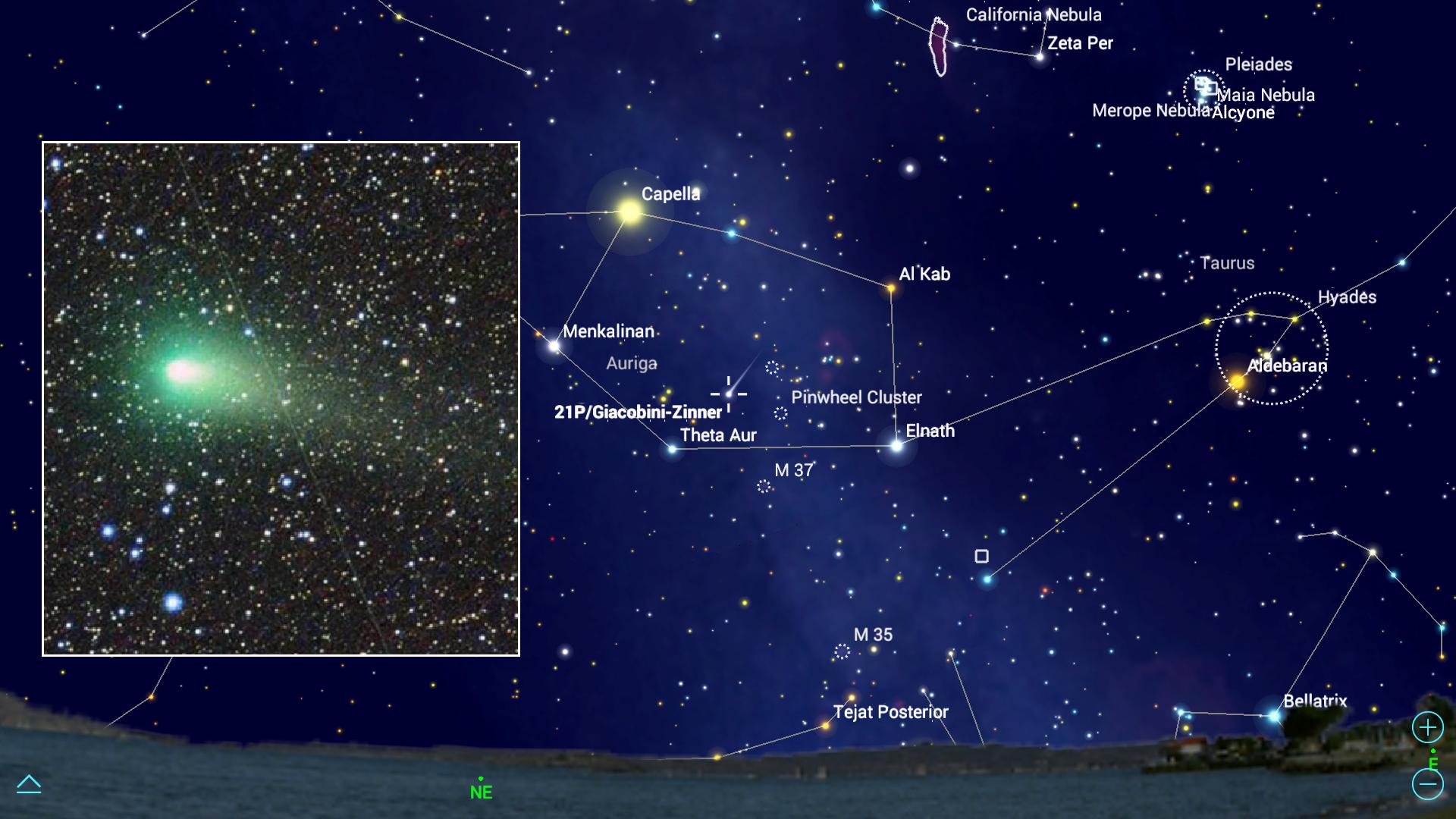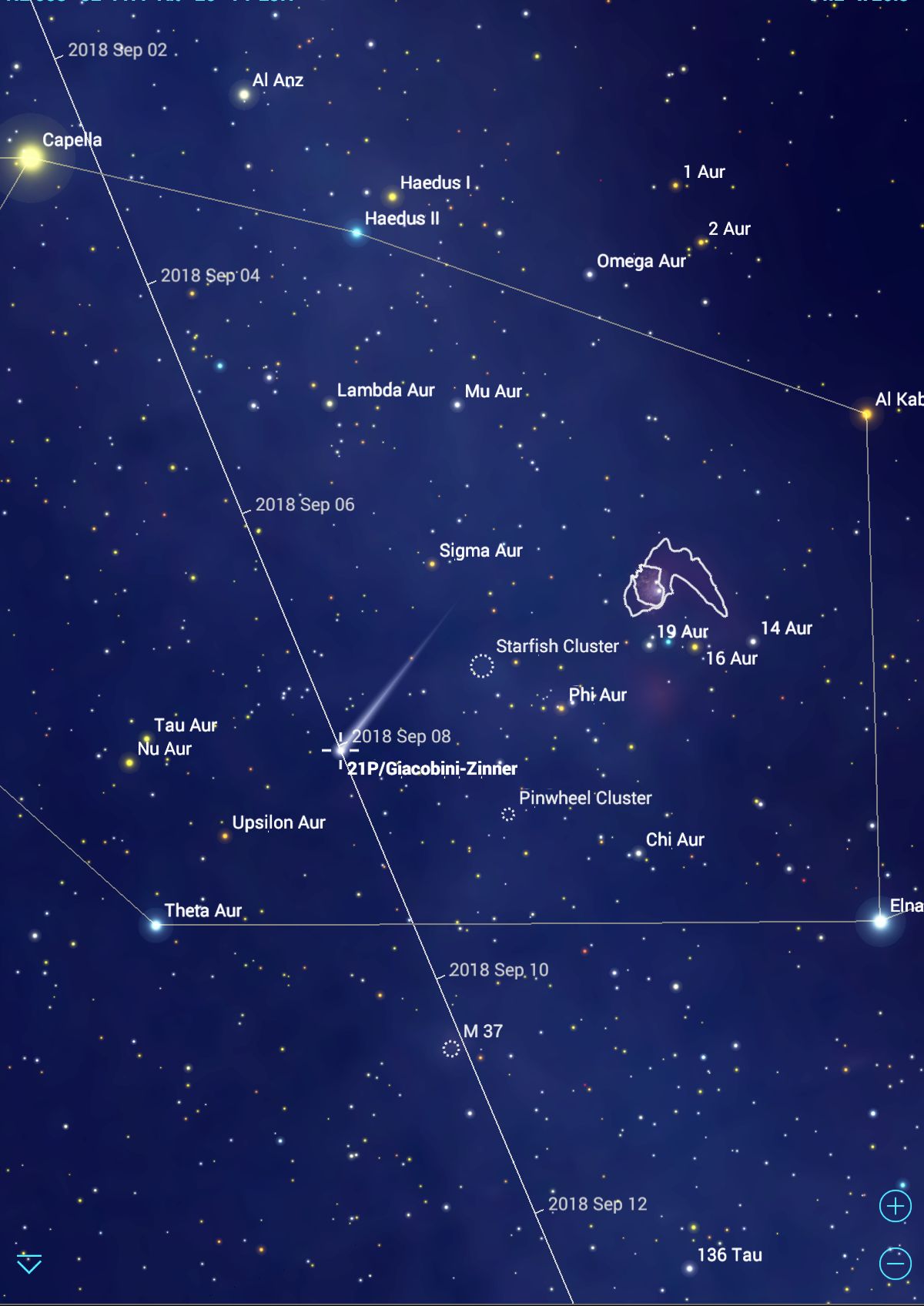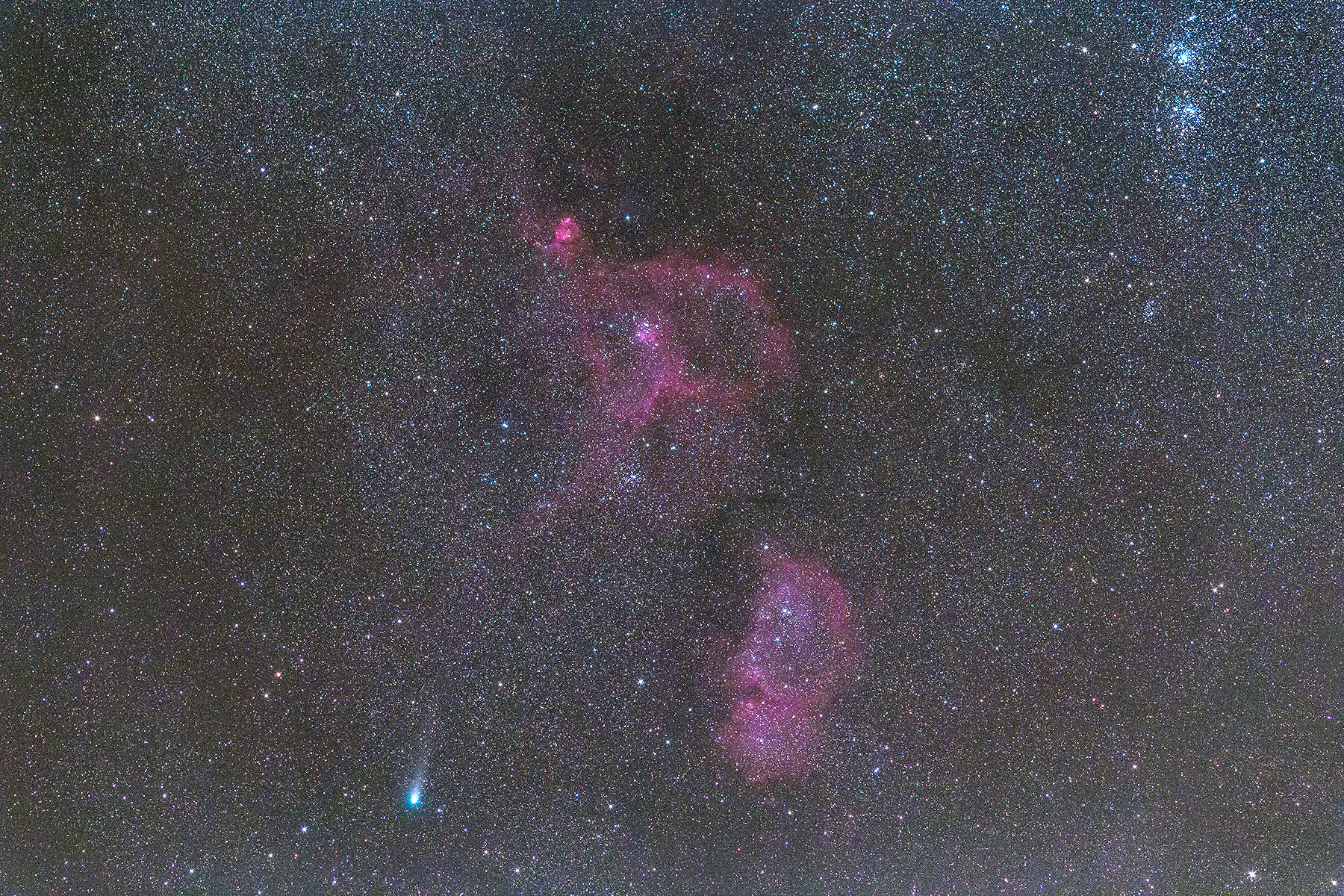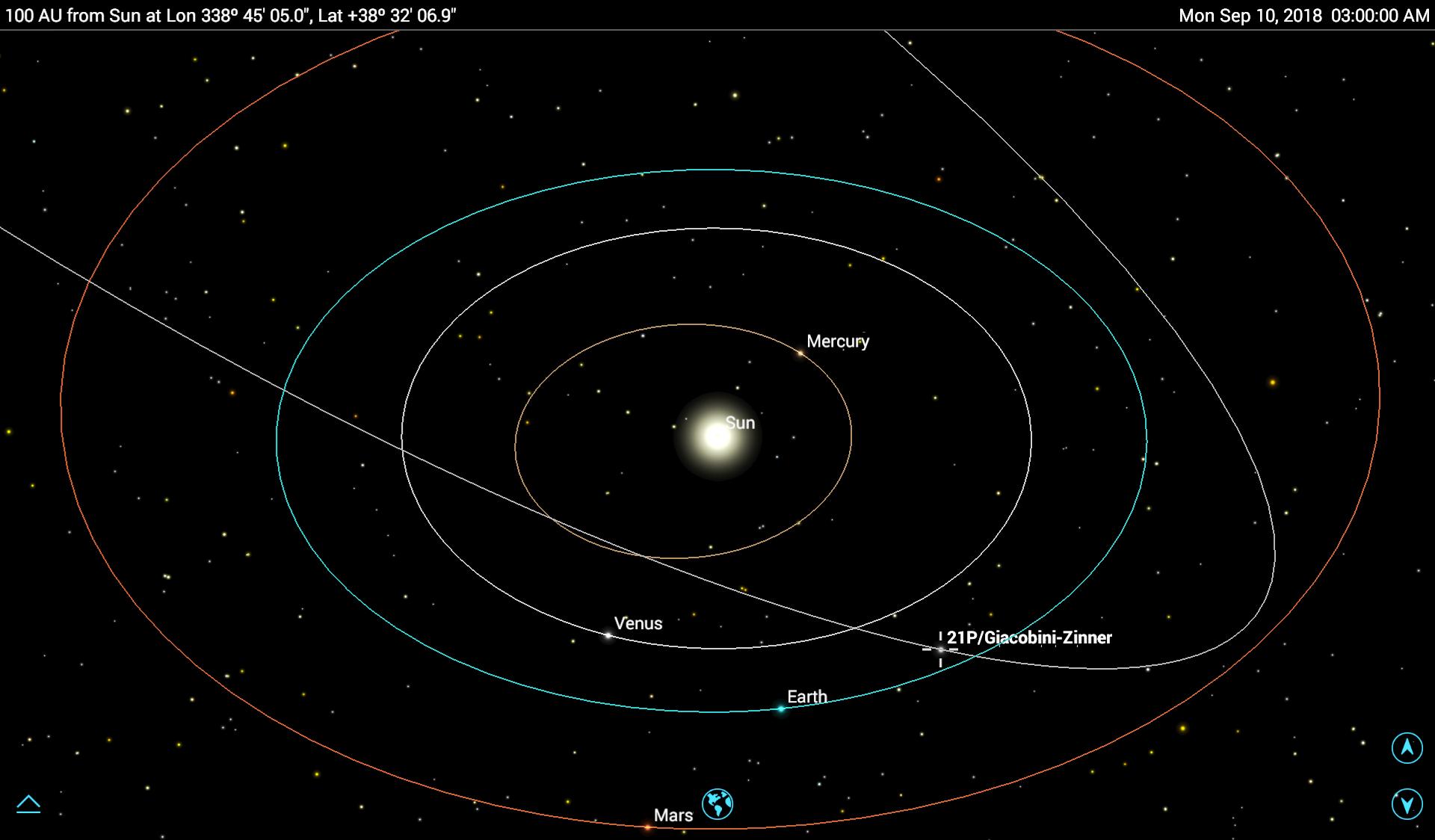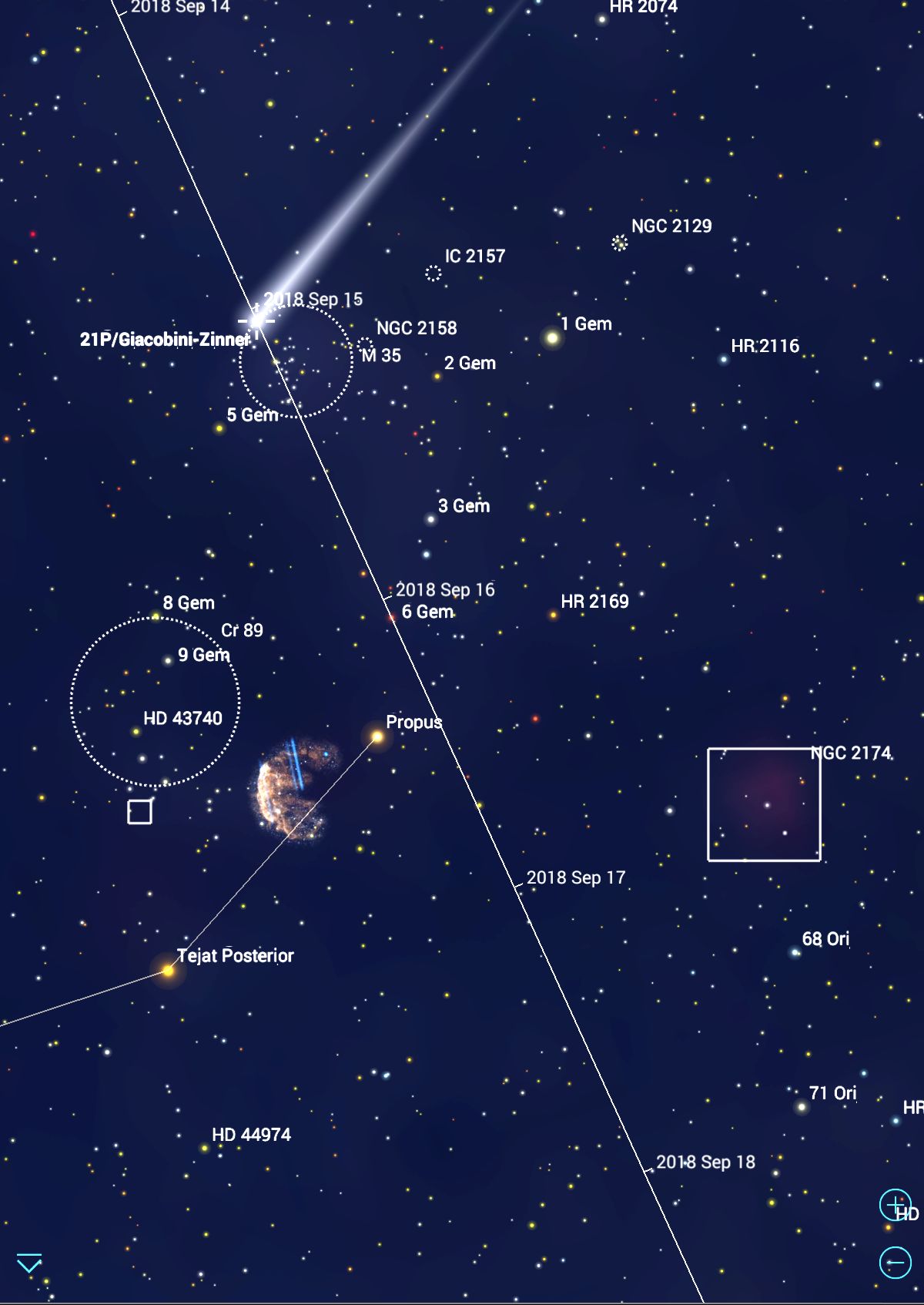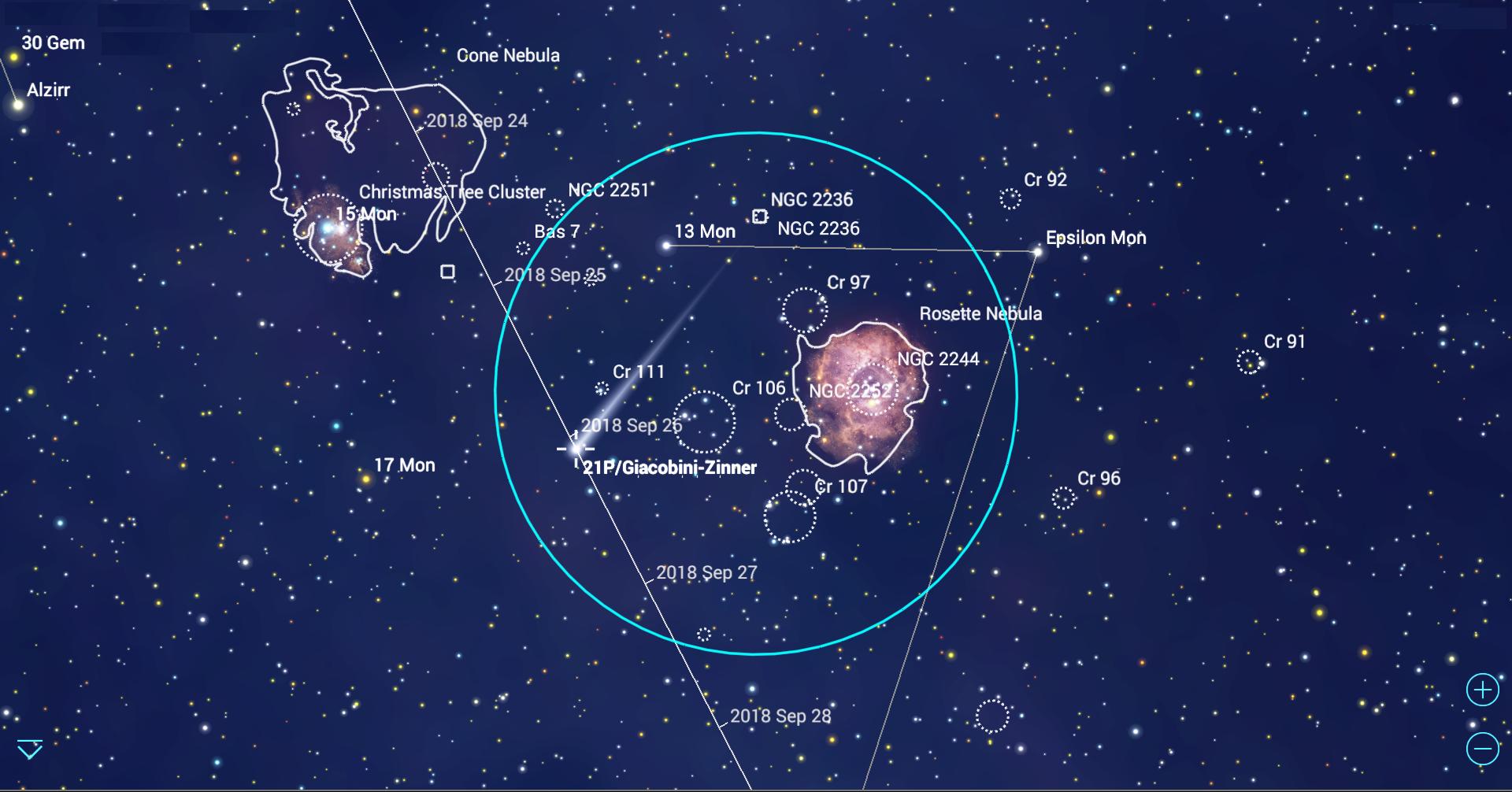Spotting the Comets of 2018 and Tracking Their Spectacular Encounters Using Mobile Apps
It's been quite a while since a bright, naked-eye comet graced the world's skies. But while we wait for the next spectacular visitor from the outskirts of our solar system, we can enjoy smaller, dimmer comets that pass close enough from time to time to be seen in binoculars and telescopes.
This month, a periodically returning comet designated 21P/Giacobini-Zinner will be bright enough to be seen in binoculars and small telescopes. It is expected to continue to brighten until the morning of Sept. 10, when it will pass within 36.3 million miles (58.5 million kilometers) of Earth on its way around the sun.
Sometimes, if its orbit is just right, a comet will appear to pass close to major stars in the sky, which makes it easier for non-experts to find the object. And, even better, comets occasionally pass close to the positions in the sky of distant deep-sky objects. This sets up spectacular telescope views and wide-field photo opportunities for tripod-mounted cameras or close-up views using DSLR cameras affixed to tracking telescopes. [Amazing Photos of Comet 21P/Giacobini-Zinner and Comet 46P/Wirtanen]
Lucky for us, Comet 21P's path will take it along the Milky Way, setting up a series of spectacular close encounters during September and October. And many of the best ones will occur when the moon is not very bright, as is the case this week.
In this edition of Mobile Stargazing, we'll tell you how to use your favorite astronomy app to hunt down Comet 21P. We'll also present a timeline of events that will give you the opportunity to see or photograph the comet in a picturesque setting.
And Comet 21P will just be a warm-up. Astronomers eagerly anticipate the arrival later this year of another, even brighter comet: 46P/Wirtanen.
Finding Comet 21P in the sky
Comet 21P/Giacobini-Zinner is located in the northeastern sky and is visible in both the Northern and Southern hemispheres. It rises in late evening and then is carried higher in the sky as the night wears on. Right now, the comet's brightness is approximately magnitude 7.5, and skywatchers have spotted it easily using binoculars in dark-sky locations. [Bright Comets of 2018: When, Where and How to See Them]
Breaking space news, the latest updates on rocket launches, skywatching events and more!
This comet's orbit is inclined by 32 degrees from our solar system's plane, so rather than moving east-west as the moon and planets do, it follows a southward path through the stars — which is down and toward the right for Northern Hemisphere observers. Between now and Sept. 13, the comet will pass through the roughly circular constellation Auriga. After that, 21P will move through the feet of Gemini's western twin, Castor, for a few nights and then follow the boundary between Orion and Gemini until Sept. 22.
The comet will finish September by following the Milky Way, traveling through the modest constellation of Monoceros, more or less toward the very bright star Sirius. Then, 21P will spend October skirting the eastern edge of Canis Major. It's unknown how long the comet will remain a target for binoculars, but telescope users with tracking capability should be able to find and view 21P for the next two months or so.
You can use your astronomy app to display the path of a comet against the sky. In the SkySafari app Plus and Pro versions, use the search option, select the comet and tap the Center icon on the Info page. Open the Settings/Solar System menu and put a check mark in the Selected Object Path box. The sky will now include the comet's path, with labeled tick marks at one-day intervals. You can also advance to future dates and see where the comet will be at any given date and time. [Best Binoculars for Earth and Sky]
Comet 21P encounters
Below is a timeline of encounters for Comet 21P through the end of October. The times and locations are based on the currently predicted orbit of the comet and are subject to change. Apps such as SkySafari 6 for Android and iOS will update orbital parameters as they change.
You can preview each encounter by setting your app to the appropriate date and then selecting and centering the comet in the display. Configure the app's displayed field of view to include some of the surrounding sky. Because the comet will be moving quickly, its distance from objects will vary depending on the part of the world where you're observing. Adjust the time forward or back in your app to determine the best time to see each pairing at your location.
The comet will be observable worldwide, from mid-southern latitudes all the way to the Arctic, but Southern Hemisphere skywatchers will need to wait until the predawn hours for the comet to climb high enough to be seen clearly. In the descriptions, I provide the optimum viewing time for the Eastern Time zone and the corresponding Greenwich Mean Time (GMT). The comet will not be high enough for skywatchers to observe it until after midnight, so events in the list happen in the early hours on the date listed, i.e., after midnight on the preceding date. I have included some screen captures to illustrate the encounters.
I have provided the suggested observing tools for each encounter. The direction indications of "left and right" and "up and down" are for observers in the Northern Hemisphere. Reverse those if you are looking from south of the equator.
Sept. 8 after midnight EDT (after 0500 GMT) — The comet will pass 2.5 degrees west (left) of two bright open star clusters in Auriga designated Messier 38 and Messier 36 (use binoculars).
Sept. 9 to 10 — On these nights, the comet will pass between the bright stars Mahasim (Theta Aurigae) and Elnath (Beta Aurigae) while heading south (downward). The object will be somewhat closer to Mahasim, the dimmer, left-hand star (use binoculars).
Sept. 10 — On Sept. 10, the comet will reach its closest point to both the sun and to Earth. Around this date, we expect the object to peak in visual brightness: around magnitude 7.0.
Sept. 10 to 11 — On these nights, the comet will glide past the open star cluster designated Messier 37, passing only 10 arc minutes (or one-third of the full moon's diameter) from the cluster at 1900 GMT on Sept. 10. Observers in Asia and Oceania will see the objects close together. Most of the Western Hemisphere will have to settle for seeing the comet 1 degree from the cluster on each night (best viewed in a telescope).
Sept. 15 — At about 6 a.m. in the Eastern time zone (1000 GMT), the comet will glide directly through the open star cluster designated Messier 35 (use a telescope).
Sept. 16 — During the night, the comet will approach the bright star Propus (Eta Geminorum), passing within 0.5 degrees west (to the upper right) of the star just before dawn. The Jellyfish Nebula (IC 443) will be within a telescope's field of view at low magnification. Closest approach to Propus will occur at around 1500 GMT, and the event is visible only for skywatchers in Asia and Oceania (use binoculars or a telescope). [Best Telescopes for the Money: 2018 Reviews and Guide]
Sept. 17 — In the early hours of Sept. 17, the comet will be positioned below Propus and approximately midway between the bright star Tejat (Mu Geminorum) and NGC 2174, also known as the Monkey Head Nebula. The comet and the nebula will appear together in the field of view of a low-magnification telescope.
Sept. 23 — The comet will begin to move across the plane of our galaxy. During this night, the comet will pass near a collection of dim deep-sky objects in northern Monoceros, including the star clusters and nebulas designated NGC 2247, NGC 2245, IC 2167, IC 2169 and NGC 2259 (use a telescope). Note: The nearly full moon will wash out the sky somewhat for this encounter.
Sept. 24 — On this night, the comet will pass about 1 degree east (to the right) of NGC 2264, also known as the Christmas Tree Cluster. Both objects will fit in the field of view of a telescope. On the next night, the nebula will still be less than 2 degrees from the comet. Note: The full moon will wash out the sky somewhat for this encounter.
Sept. 26 — Look for the comet sitting 3 degrees northeast (to the left) of the spectacular star cluster and nebula combination known as the Rosette Nebula (NGC 2244) in Monoceros. This pairing will make an excellent wide-field photo opportunity and sight in binoculars. Note, the waning full moon will wash out the sky somewhat for this encounter.
Oct. 7 to 8 — On these dates, the comet will glide past the open star cluster designated Messier 50 in southern Monoceros. Closest approach, with the comet skimming the cluster's outskirts, will occur at 1900 GMT on Sept. 7 — an event visible only to Asia and Oceania. North American observers will see the comet positioned about 0.5 degrees from the cluster on those two mornings (first above and then below). (Use binoculars or a telescope.)
Oct. 9 to 10 — On these two mornings in the predawn hours, the comet will move past the bright Seagull Nebula (IC 2177) and then descend through the large and faint reflection nebula designated IC 2327. Other nearby objects will include the star clusters NGC 2335 and NGC 2343. This will be another wide-field photo opportunity, as well as a sight visible via binoculars and telescope.
By the end of October, astronomers expect Comet 21P/Giacobini-Zinner to fade below the range where binoculars can find it easily. In the meantime, users of GoTo tracking telescopes can continue to track the comet as it passes the Thor's Hammer Nebula (NGC 2359) on Oct. 13, Caroline's Cluster (NGC 2360) on Oct. 15, Charlie Brown's Christmas Tree Cluster (NGC 2367) on Oct. 22 and more. Use your astronomy app to preview all of the dates and mark your calendars for the events you wish to observe or photograph.
Comet 46P/Wirtanen preview
Comet 46P/Wirtanen is another eagerly anticipated periodic comet, and it will round the sun on Dec. 12, 2018. This one, when viewed under a dark sky, is predicted to reach naked-eye brightness of magnitude 3 around Dec. 16, when the object will pass closest to Earth.
Right now, the comet is in Cetus, located over the southern horizon after midnight local time — tickling the belly of that whale-shaped constellation. In late November, the comet will begin to climb the southern sky and enter southwestern Taurus around the perihelion date. That means the object will be perfectly placed for mid-evening viewing!
Let's cross our fingers that Comet Wirtanen lives up to expectations. In the meantime, you can practice your comet-spotting on Comet Giacobini-Zinner. If you capture any images of either comet's close encounters, be sure to share them with Space.com.
In upcoming editions of Mobile Astronomy, we'll show how constellations will look different in the far future, how to use mobile apps to plan and log astronomical observations, and more. Until then, keep looking up!
Editor's note: Chris Vaughan is an astronomy public-outreach and education specialist at AstroGeo, a member of the Royal Astronomical Society of Canada, and an operator of the historic 74-inch (1.88 meters) David Dunlap Observatory telescope. You can reach him via email and follow him on Twitter @astrogeoguy, as well as on Facebook and Tumblr.
This article was provided by Simulation Curriculum, the leader in space science curriculum solutions and the maker of the SkySafari app for Android and iOS. Follow SkySafari on Twitter @SkySafariAstro. Follow us @Spacedotcom, Facebook and Google+. Original article on Space.com.

Chris Vaughan, aka @astrogeoguy, is an award-winning astronomer and Earth scientist with Astrogeo.ca, based near Toronto, Canada. He is a member of the Royal Astronomical Society of Canada and hosts their Insider's Guide to the Galaxy webcasts on YouTube. An avid visual astronomer, Chris operates the historic 74˝ telescope at the David Dunlap Observatory. He frequently organizes local star parties and solar astronomy sessions, and regularly delivers presentations about astronomy and Earth and planetary science, to students and the public in his Digital Starlab portable planetarium. His weekly Astronomy Skylights blog at www.AstroGeo.ca is enjoyed by readers worldwide. He is a regular contributor to SkyNews magazine, writes the monthly Night Sky Calendar for Space.com in cooperation with Simulation Curriculum, the creators of Starry Night and SkySafari, and content for several popular astronomy apps. His book "110 Things to See with a Telescope", was released in 2021.

